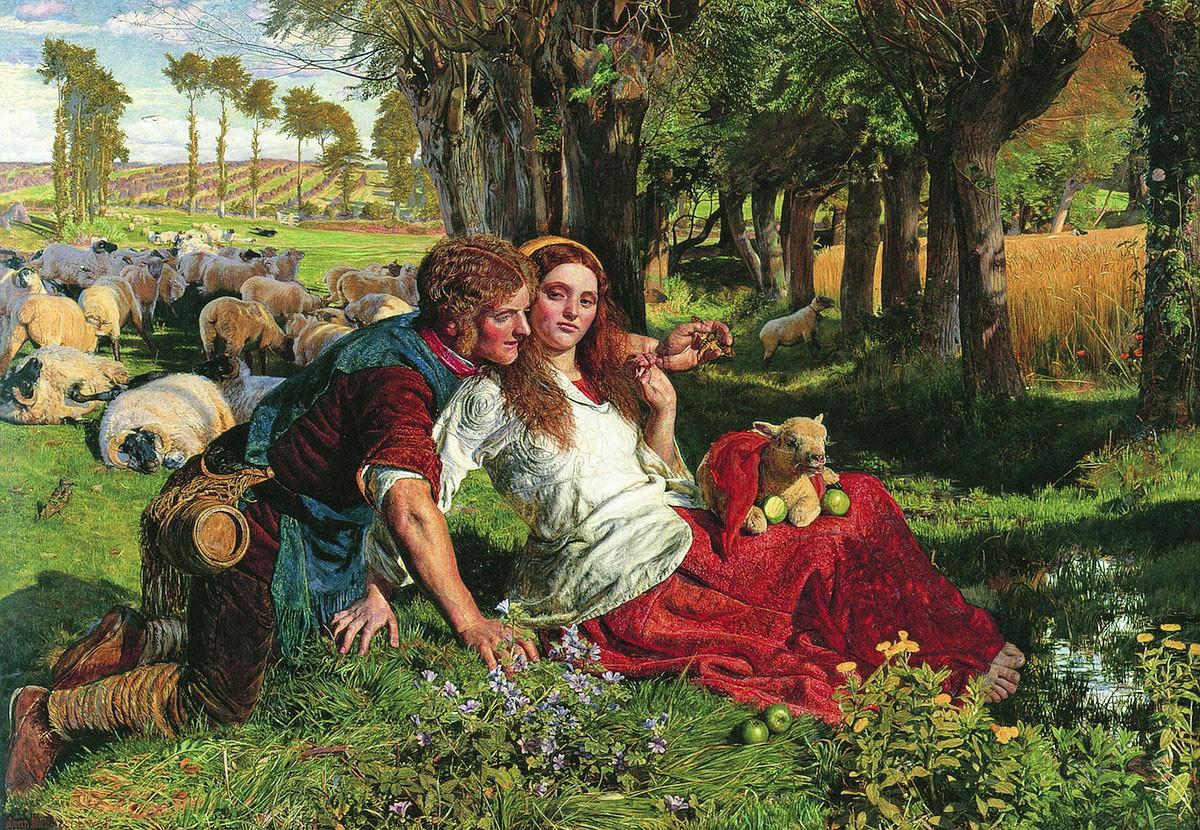Created by Natalia Salamon on Sat, 10/24/2020 - 01:45
Description:
The Hireling Shepherd is an oil painting on canvas by Pre-Raphaelite artist William Holman Hunt circa 1851. Hunt travelled alongside John Everett Millais, another member artist of the Pre-Raphaelite Brotherhood, to Ewell, Surrey. Together, they searched for locations for inspiration in their artwork. While Millais began painting Ophelia near the River Hogswell, Hunt chose a meadow to paint The Hireling Shepherd. Ford Madox Brown set the foundation of modern-life realist style painting for the Pre-Raphaelites. Rossetti was intrigued by Brown’s depth in his painting by painting in the outdoors. The rest of the members followed this inspiration. Hunt and Millais encountered natural problems in painting outdoors such as flies and unfavorable weather conditions. It is said that these conditions forced them to work under shelter and they spent 11 hours a day for about five months laboring over their paintings (“The Hireling Shepherd”). The finished product of The Hireling Shepherd was exhibited at the Royal Academy accompanied by a quote from Shakespeare’s King Lear:
“Sleepest or wakest thou, jolly shepherd?
Thy sheep be in the corn;
And for one blast of thy minikin mouth,
Thy sheep shall take no harm” [III.VI]
What at first glance appears to be a comforting, innocent rural setting, there appear subtle disturbances of the harmony of the painting. While painted with the Pre-Raphaelite characteristic of naturalism, the subject of the painting presents itself as Victorian moralism: “a warning against the dangers of alcohol, casual sex, and idleness”, (“When Leadership Fails…”). Hunt’s inclusion of Shakespeare's quote, which critiques the failure of duties of a shepherd, only proves some of his complex intentions of the painting. In addition, the work of art echoes Biblical allusions which was a theme in Pre-Raphaelite art. The story of The Good Shepherd in the Book of John, Chapter 10:
“I am the good shepherd: the good shepherd giveth his life for the sheep. But he that is an hireling, and not the shepherd, whose own the sheep are not, seeth the wolf coming, and leaveth the sheep, and fleeth. […] The hireling fleeth, because he is an hireling, and careth not for the sheep.”
The literary parallels emphasize the need for a good work ethic. The laxity that occurs during one’s job can hold potential harm to themselves as a citizen and to their environment.
The painting portrays what seems to be a couple, a man and a woman, sitting on the field reclined. The man, clearly a shepherd, is neglecting his flock of sheep. His mind is clearly not on the sheep but instead this beautiful woman in front of him. In the shepherd’s left hand, he is holding to what appears a death’s head hawkmoth. This insect gets its name from the skull shape on its back. Many cultures equate the moth to the symbol of death (Marshall). The symbol of death could have many meanings in Hunt’s painting. First, in the upper right corner appear a grand heard of sheep. Two have already collapsed in the field. Due to the inactivity of the shepherd, one can assume that the sheep are in poor health. It is harmful to sheep to overeat, and as one can see, there is plenty of wheat near the sheep that they could have grazed without limit. The death’s head hawkmoth can symbolize quite literally the death of the sheep or more deeply, the death of the environment that the shepherd invoked due to his negligence.
On an even metaphorical level, the message behind this painting points out the consequences of allowing one’s “flock” to visit unfamiliar “pastures”. The woman is dressed in a loose-fitting dress which is a vibrant red. At a glance, an observer’s attention in drawn to the color of her dress. When taking a closer look, it is difficult to tell the exact facial expression of the woman, but it is uninviting. She is obviously seduced by this young shepherd as his hand is around her shoulder. In her lap lay a half-eaten apple, and a lamb which Biblically is a symbol of peace, gentleness, as well as sacrifice. These details reference the Old Testament temptation of Adam and Eve in the Garden of Eden. Both the woman and Eve are victims of naïve temptation. An additional interpretation of the moth that the shepherd is holding is that he is showing her the death of her innocence. He will be the one that takes advantage of her.
Moreover, there can be much more said about women by focusing on the smaller details. Her loose-fitting outfit and the fact that she is barefoot suggest that she is from the rural working class. Although her body is quite visible to the eye, her positioning is very closed off. When looking at her feet, she keeps them together so much so that her toes are touching. This proposes that she in fact holds herself to a moral standard, but she will be soon morally misguided by lust. What is interesting is that she is also wearing a yellow headband which is very youthful.
In conclusion, William Holman Hunt’s The Hireling Shepherd suggests the condition of sexual relationships and attitudes toward women by alluding to Biblical and Shakespearean literature, as well as the Pre-Raphaelite style of realism.
Bibliography
Marshall, Michael. “Earth - The Sinister Moth from Silence of the Lambs Can Squeak.” BBC, BBC, 5 Aug. 2015
Shakespeare, William, et al. The Tragedy of King Lear. Cambridge University Press, 2020
“The Hireling Shepherd.” The Hireling Shepherd by William Holman Hunt, www.williamholmanhunt.org/hireling-shepherd
“When Leadership Fails: Holman Hunt and 'The Hireling Shepherd'.” Pneuma, 8 Nov. 2017, www.pneuma.org.uk/art/when-leadership-fails-holman-hunt-and-the-hireling...


